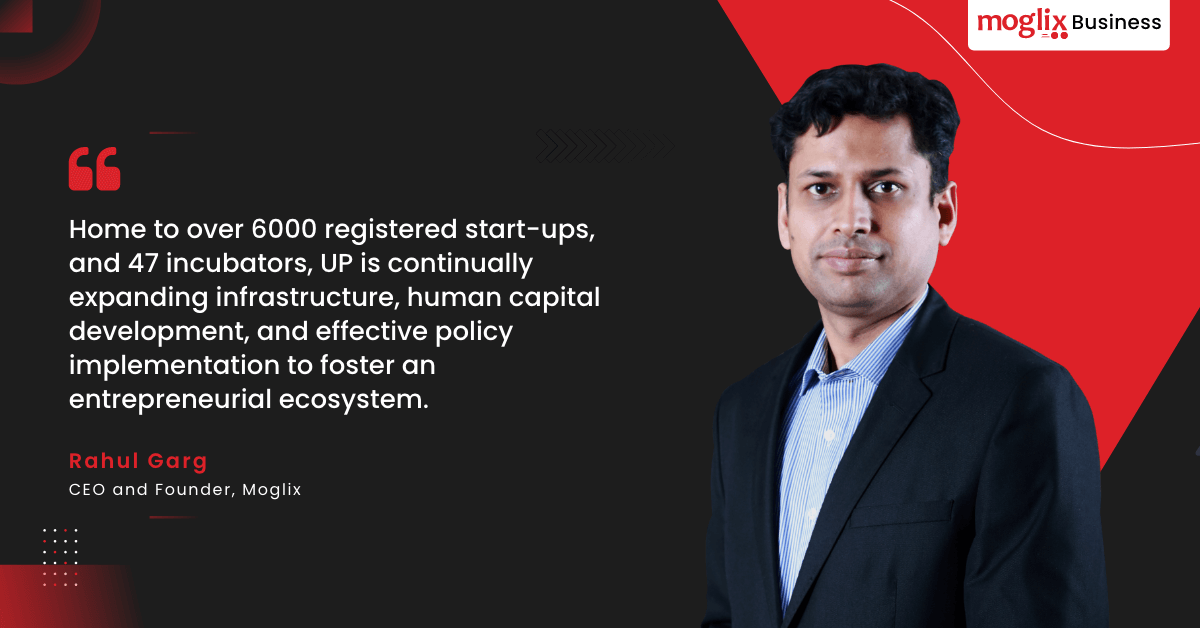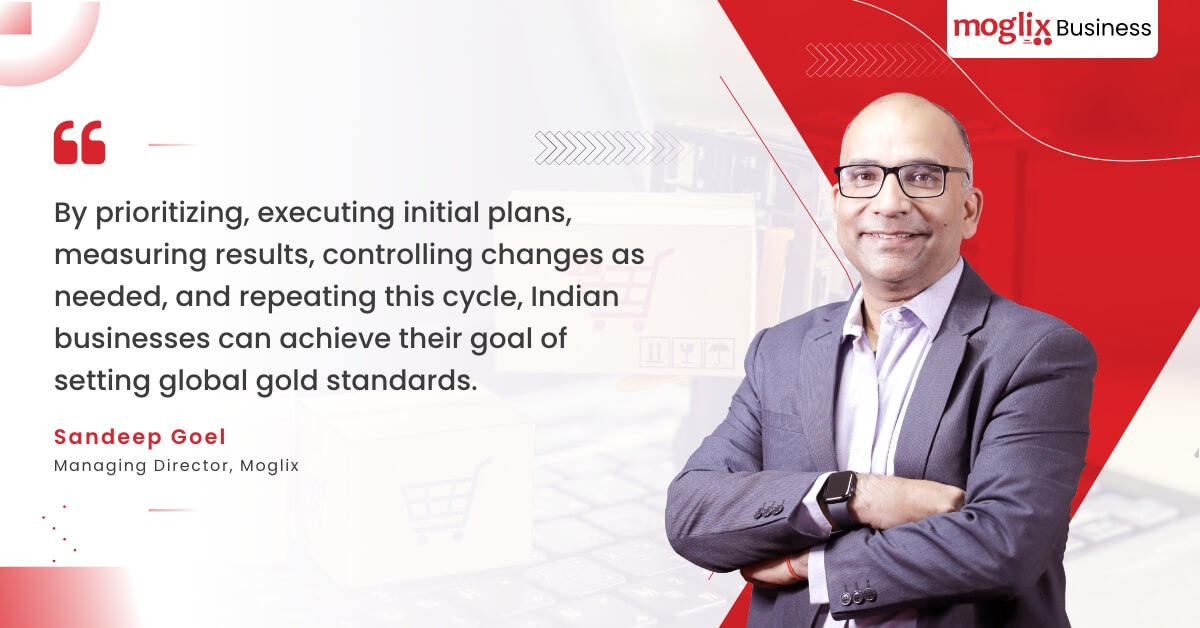Breaking Barriers: How Manufacturing and Start-Ups are Paving the Way for B2B Success in Uttar Pradesh

Breaking Barriers: How Manufacturing and Start-Ups are Paving the Way for B2B Success in Uttar Pradesh
By virtue of its investor-friendly policies and ease of doing business, Uttar Pradesh is fast emerging as the most preferred investment destination . Supported by a robust and growing start-up environment, the state is on the road to achieve its target of 1 trillion USD economy by 2030.
By 2030, India will have the manufacturing potential to export goods worth $1 trillion, putting it on the global manufacturing map. One of India’s most important economic pillars is the manufacturing industry, which employs over 27.3 million people and accounts for 17 percent of GDP.
Breaking Boundaries: An Interview with Sandeep Goel, MD of Moglix on the Power of Getting Uncomfortable

Breaking Boundaries: An Interview with Sandeep Goel, MD of Moglix on the Power of Getting Uncomfortable
Late November in 2022, I boarded a flight from Delhi to Hyderabad, and walked through the aerobridge, as I was greeted by a smiling airhostess “Sir, welcome aboard” it suddenly struck me that I was without mask, and she did not ask me to put one either. I had an almost instant smile on my face as the realisation dawned that Covid is now officially a thing of the past. The realization triggered a series of happy feelings – freedom, excitement, relief and above all finally “being normal”. And I reflected what a year it has been – 2022, a year of challenges and triumphs.
Prioritization was to ensure we spend our time on the right set of things, and rigor was required to ensure we do a good job of delivering on selected priorities when you run things on high rigor, conflicts are bound to come up.
Sandeep Goel said
Why We Need to Rethink PPE for Women in Industry?

Why We Need to Rethink PPE for Women in Industry?
When we think of personal protective equipment (PPE) in the industrial sector, we will likely picture a bulky suit and helmet on a male worker. However, this image fails to acknowledge the millions of women working in industries that require PPE. Women face unique challenges in the workplace, including ill-fitting PPE and inadequate safety gear, which can expose them to dangerous working conditions.
Despite the pressing need for gender-specific PPE, a recent Women in Global Health study(1) reveals that about three-quarters of the women surveyed experienced problems with PPE fit, and a mere 14% reported using exclusively fit-tested PPE. This alarming finding is a cause for concern as poorly fitting PPE can lead to reduced productivity, injuries, and in severe cases, fatalities. The fact that women face such challenges in obtaining appropriate PPE should be treated as a critical issue that requires our immediate attention to ensure women’s safety at manufacturing facilities.
One Size Does Not Fit All: The Gender Gap in PPE Procurement
The lack of awareness within some organizations of women’s unique PPE needs and female-friendly safety equipment is a primary challenge women face. The all too common “one size fits all” strategy is often employed in PPE procurement, leading to employers neglecting the purchase of PPE designed for women and displaying indifference towards their safety.
Additionally, the male-dominated construction industry culture presents another significant barrier to women’s access to adequately fitting PPE. Women are frequently expected to make do with PPE designed for men, modify their gear, or purchase their PPE outright. This culture of indifference must be challenged, and solutions must be sought to provide female worker safety in the manufacturing sector.
Procuring for Diversity: The Importance of Gender-Specific PPE
The importance of addressing PPE challenges for women cannot be overstated. In many industries, women are exposed to the same risks as men, including exposure to chemicals, heat, and electrical hazards. Without adequate protection, women are at risk of injury or even death. To be effective, the safety-oriented design and production of PPE must cater to the distinct requirements of every gender.
In addition to the moral imperative of ensuring women’s safety, there are practical reasons to address PPE challenges for women. When workers feel safe and protected, they are more likely to be productive and engaged in their work, leading to a more positive and efficient work environment.
Empowering Women with Innovative PPE Solutions: Join the Revolution
Unfortunately, many women still face unique challenges regarding selecting and using PPE in the workplace. To bridge this gap, employers must engage women in the PPE selection process and thoroughly assess their needs.
Thankfully, some manufacturers have recognized the need for gender-specific PPE and are leading the charge toward innovation in this area. Women’s PPE is now being designed to fit the female body shape, with adjustments made for height, waist size, and shoulder width differences. The use of softer materials and more flexible fabrics not only improves comfort and range of motion but also promotes safety.
Moreover, In order increase adoption women’s PPE is now being made more practical and appealing, with various colors, patterns, and form-fitting designs. This is a welcome change as it encourages women to wear their PPE more often, improving safety and reducing the risk of workplace accidents.
At Moglix, you have access to the most comprehensive range of safety supplies and solutions. You can find a range of PPE solutions specifically designed for women at workplace. Contact us today and partner with us to build a safer environment for women.
The Digital Revolution of Receivables Finance in GIFT City

The Digital Revolution of Receivables Finance in GIFT City
Date : February 27, 2023
Organizer:FCI
About the Event: Mr. Rahul Garg, Founder & CEO, Moglix & Credlix, recently shared his experiences on “Manufacture in India, for the World: Export Factoring led Growth” at The Digital Revolution of Receivables Finance in GIFT City, Gujarat.
Indian Automotive Value Chain Summit

Indian Automotive Value Chain Summit
Date : February 23, 2023
Organizer: CII
About the Event:Mr. Mukund Vasudevan, Managing Director, Moglix recently shared his perspective on ‘Transforming Indian Automotive Industry – Supply Chain Strategy, For Now, Next & Beyond’ at the Indian Automotive Value Chain Summit organized by Confederation of Indian Industry in Gurugram.
9th CFO Vision and Innovation Summit and Awards

9th CFO Vision and Innovation Summit and Awards
Date : February 17, 2023
Organizer: IMA
About the Event:: Mr. Kailash Rathi, Director, Credlix recently shared their perspective on “Choosing the right digital supply chain finance platform” at the 9th edition of CFO Vision & Innovation Summit and Awards 2023 organized by Transformance Forums.
CEO Forum Session: Tech@Core: Building a Digitally Mature Organisation

CEO Forum Session: Tech@Core: Building a Digitally Mature Organisation
Date : February 15, 2023
Organizer: IMA
About the Event:Mr. Rahul Garg, Founder & CEO, Moglix shared his thoughts on ‘Tech@Core: Building a Digitally Mature Organization’ at IMA India’s CEO Forum Session in Delhi.
Uttar Pradesh Global Investors Summit 2023

Uttar Pradesh Global Investors Summit 2023
Date : February 11, 2023
Organizer: Invest UP
About the Event:Mr. Rahul Garg, Founder & CEO, Moglix shared his thoughts on ‘Gearing for Start-up Revolution – The Next Big Opportunity in UP’ at Uttar Pradesh Global Investors Summit 2023 in Lucknow.
8th CFO Vision and Innovation Summit and Awards

8th CFO Vision and Innovation Summit and Awards
Date : February 10, 2023
Organizer: Transformance
About the Event:Mr. Rishabh Agrawal, Senior Vice President, Credlix recently shared his perspective on “Choosing the right digital supply chain finance platform” at the 8th edition of CFO Vision & Innovation Summit and Awards 2022 organized by Transformance Forums.
68th India International Garment Fair (IIGF)

68th India International Garment Fair (IIGF)
Date : February 9, 2023
Organizer: India International Garment Fair (IIGF)
About the Event: Here are some glimpses from Moglix Fashion participation at the 68th India International Garment Fair (IIGF), where we got an opportunity to showcase quality Apparel/Accessories designs in Womenswear, Menswear, Kids wear & Fashion Accessories all in one place.
